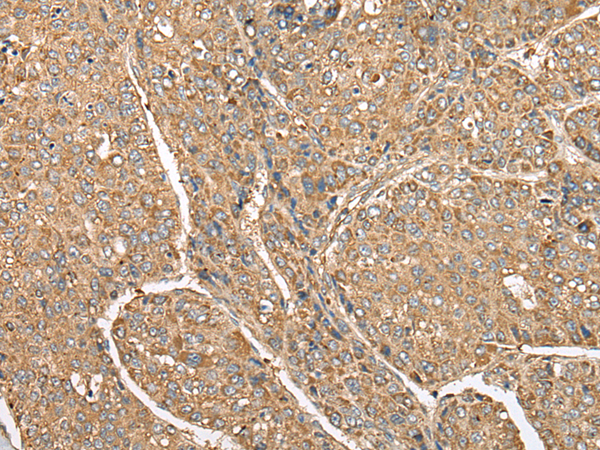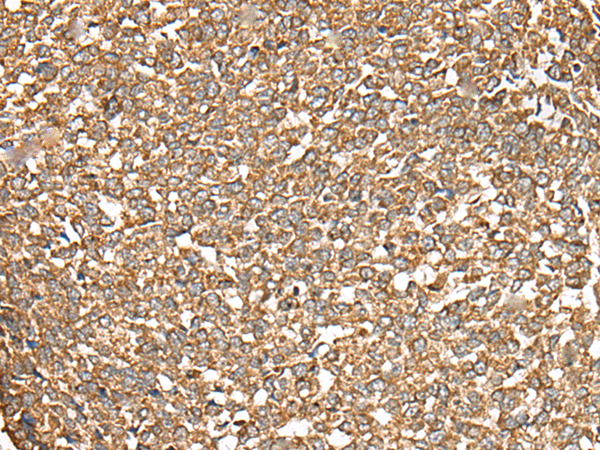

| WB | 咨询技术 | Human,Mouse,Rat |
| IF | 咨询技术 | Human,Mouse,Rat |
| IHC | 1/40-1/200 | Human,Mouse,Rat |
| ICC | 技术咨询 | Human,Mouse,Rat |
| FCM | 咨询技术 | Human,Mouse,Rat |
| Elisa | 1/5000-1/10000 | Human,Mouse,Rat |
| Aliases | C5A; C5AR; C5R1; CD88 |
| Host/Isotype | Rabbit IgG |
| Antibody Type | Primary antibody |
| Storage | Store at 4°C short term. Aliquot and store at -20°C long term. Avoid freeze/thaw cycles. |
| Species Reactivity | Human |
| Immunogen | Fusion protein of human C5AR1 |
| Formulation | Purified antibody in PBS with 0.05% sodium azide and 50% glycerol. |
+ +
以下是关于C5AR1抗体的3篇示例参考文献(内容为模拟概括,仅供参考):
1. **标题**:*Targeting C5aR1 with a monoclonal antibody improves efficacy of anti-PD-1 therapy in murine cancer models*
**作者**:Smith A, et al.
**摘要**:研究开发了一种靶向C5AR1的单克隆抗体,证明其通过抑制肿瘤微环境中C5a介导的髓系免疫抑制细胞募集,增强抗PD-1疗法的抗肿瘤效果,并在黑色素瘤和结肠癌小鼠模型中验证了协同作用。
2. **标题**:*C5aR1 antagonism reduces neuroinflammation and amyloid pathology in Alzheimer's disease models*
**作者**:Zhang L, et al.
**摘要**:该文献报道了一种人源化C5AR1抗体在小鼠阿尔茨海默病模型中的应用,显示其阻断C5a-C5AR1信号通路可减少小胶质细胞活化、神经炎症及β-淀粉样蛋白沉积,改善认知功能。
3. **标题**:*A novel anti-C5AR1 antibody attenuates rheumatoid arthritis progression by suppressing neutrophil infiltration*
**作者**:Chen H, et al.
**摘要**:研究通过体外和胶原诱导关节炎(CIA)小鼠模型,证明新型C5AR1抗体能有效抑制C5a诱导的中性粒细胞迁移和滑膜炎症,显著减轻关节破坏和疾病活动度。
---
**注意**:以上文献为示例性内容,实际文献需通过PubMed、Web of Science等数据库检索。建议使用关键词“C5AR1 antibody”或“CD88 antagonist”筛选近年研究。
C5aR1 (C5a receptor 1), also known as CD88. is a G protein-coupled receptor (GPCR) that binds to the complement component C5a, a potent pro-inflammatory peptide generated during complement system activation. This receptor plays a central role in inflammatory and immune responses by mediating chemotaxis, cytokine release, and leukocyte activation. Dysregulation of C5a-C5aR1 signaling is implicated in various pathological conditions, including sepsis, rheumatoid arthritis, inflammatory bowel disease, and cancer progression, making it a therapeutic target of interest.
C5aR1 antibodies are tools designed to modulate this pathway. As research reagents, they enable the detection and quantification of C5aR1 expression in cells and tissues, aiding mechanistic studies. Therapeutically, neutralizing antibodies against C5aR1 or C5a aim to disrupt the receptor-ligand interaction, thereby attenuating excessive inflammation. For example, antagonists blocking C5aR1 have shown potential in preclinical models of autoimmune diseases and acute inflammatory syndromes. Conversely, agonist antibodies might be explored in contexts requiring immune activation, such as enhancing antitumor responses.
Recent advances include the development of humanized monoclonal antibodies and small-molecule inhibitors targeting C5aR1. with several candidates in clinical trials for conditions like COVID-19-associated lung injury and hidradenitis suppurativa. Challenges remain in balancing efficacy with safety, as broad suppression of C5aR1 may compromise host defense. Ongoing research focuses on optimizing antibody specificity, pharmacokinetics, and tissue targeting to improve therapeutic outcomes.
×